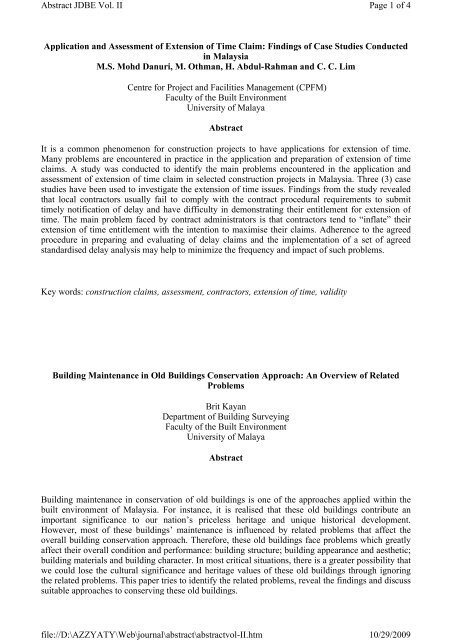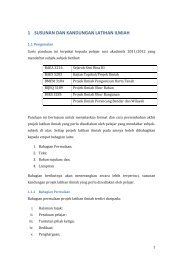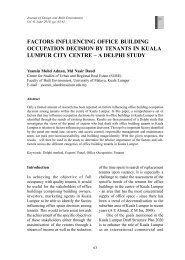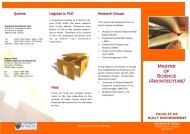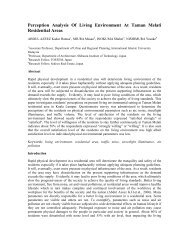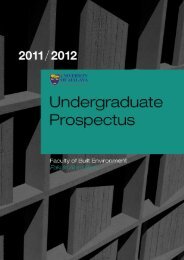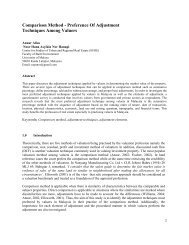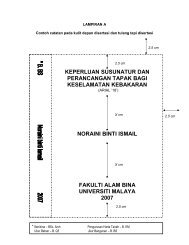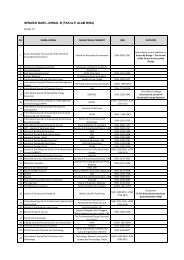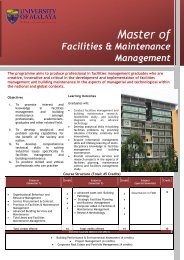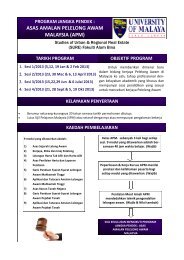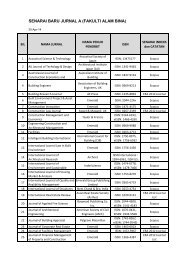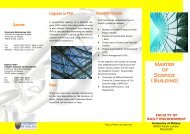Abstracts Vol.2 - Faculty of Built Environment
Abstracts Vol.2 - Faculty of Built Environment
Abstracts Vol.2 - Faculty of Built Environment
Create successful ePaper yourself
Turn your PDF publications into a flip-book with our unique Google optimized e-Paper software.
Abstract JDBE Vol. IIfile://D:\AZZYATY\Web\journal\abstract\abstractvol-II.htmPage 1 <strong>of</strong> 410/29/2009Application and Assessment <strong>of</strong> Extension <strong>of</strong> Time Claim: Findings <strong>of</strong> Case Studies Conductedin MalaysiaM.S. Mohd Danuri, M. Othman, H. Abdul-Rahman and C. C. LimCentre for Project and Facilities Management (CPFM)<strong>Faculty</strong> <strong>of</strong> the <strong>Built</strong> <strong>Environment</strong>University <strong>of</strong> MalayaAbstractIt is a common phenomenon for construction projects to have applications for extension <strong>of</strong> time.Many problems are encountered in practice in the application and preparation <strong>of</strong> extension <strong>of</strong> timeclaims. A study was conducted to identify the main problems encountered in the application andassessment <strong>of</strong> extension <strong>of</strong> time claim in selected construction projects in Malaysia. Three (3) casestudies have been used to investigate the extension <strong>of</strong> time issues. Findings from the study revealedthat local contractors usually fail to comply with the contract procedural requirements to submittimely notification <strong>of</strong> delay and have difficulty in demonstrating their entitlement for extension <strong>of</strong>time. The main problem faced by contract administrators is that contractors tend to “inflate” theirextension <strong>of</strong> time entitlement with the intention to maximise their claims. Adherence to the agreedprocedure in preparing and evaluating <strong>of</strong> delay claims and the implementation <strong>of</strong> a set <strong>of</strong> agreedstandardised delay analysis may help to minimize the frequency and impact <strong>of</strong> such problems.Key words: construction claims, assessment, contractors, extension <strong>of</strong> time, validityBuilding Maintenance in Old Buildings Conservation Approach: An Overview <strong>of</strong> RelatedProblemsBrit KayanDepartment <strong>of</strong> Building Surveying<strong>Faculty</strong> <strong>of</strong> the <strong>Built</strong> <strong>Environment</strong>University <strong>of</strong> MalayaAbstractBuilding maintenance in conservation <strong>of</strong> old buildings is one <strong>of</strong> the approaches applied within thebuilt environment <strong>of</strong> Malaysia. For instance, it is realised that these old buildings contribute animportant significance to our nation’s priceless heritage and unique historical development.However, most <strong>of</strong> these buildings’ maintenance is influenced by related problems that affect theoverall building conservation approach. Therefore, these old buildings face problems which greatlyaffect their overall condition and performance: building structure; building appearance and aesthetic;building materials and building character. In most critical situations, there is a greater possibility thatwe could lose the cultural significance and heritage values <strong>of</strong> these old buildings through ignoringthe related problems. This paper tries to identify the related problems, reveal the findings and discusssuitable approaches to conserving these old buildings.
Abstract JDBE Vol. IIfile://D:\AZZYATY\Web\journal\abstract\abstractvol-II.htmPage 2 <strong>of</strong> 410/29/2009Keywords:Building Maintenance, Old Buildings, Building Conservation ApproachInnovative Teaching <strong>of</strong> Building Technology to Architecture Students in MalaysiaS P Rao and Ezrin ArbiDepartment <strong>of</strong> Architecture<strong>Faculty</strong> <strong>of</strong> the <strong>Built</strong> <strong>Environment</strong>University <strong>of</strong> MalayaAbstractArchitecture teaching involves not only the teaching <strong>of</strong> art and aesthetics but also the science <strong>of</strong>building. With the increased use <strong>of</strong> high-rise construction, intelligent building features as well as theuse <strong>of</strong> Building Services to make the buildings habitable, it becomes imperative that the students <strong>of</strong>architecture understand and appreciate the complexities <strong>of</strong> the engineering systems to make thebuildings sustainable and energy efficient. The process <strong>of</strong> Architecture design starts with the sketchdesign by the architect. At this point, many major decisions are being made with respect to theorientation, fenestration, service cores, environmental control systems etc. These preliminary designdecisions would affect the overall energy efficiency <strong>of</strong> the building as such. It is thus necessary forthe architecture student to comprehend and assimilate advanced building technologies. This paperpresents a novel approach adopted in the Department <strong>of</strong> Architecture at the University <strong>of</strong> Malaya,commencing from the academic session 2005-2006 for the teaching <strong>of</strong> Advanced BuildingTechnology to Year 4 students.Keywords:Building Technology, Energy conservation, Intelligent buildings, Building ServicesThe Effect <strong>of</strong> Ro<strong>of</strong> Angles on Indoor Air Temperatures in Terrace Houses in MalaysiaB. Ramly and M. A. A. HussainCentre for Equatorial Sustainable Design<strong>Faculty</strong> <strong>of</strong> the <strong>Built</strong> <strong>Environment</strong>University <strong>of</strong> MalayaAbstractThe main aim <strong>of</strong> energy efficiency in building design is to create buildings that utilise minimumamount <strong>of</strong> energy while meeting the comfort standards as high as or higher than those provided byconventional buildings. To achieve these standards, it is necessary to study the local environment in
Abstract JDBE Vol. IIfile://D:\AZZYATY\Web\journal\abstract\abstractvol-II.htmPage 3 <strong>of</strong> 410/29/2009order to assess its positive and negative features (impact on the building). The results will provide abasic understanding <strong>of</strong> heat transfer and human thermal comfort requirements. It also providesfoundation for which an energy efficient design <strong>of</strong> buildings can be established.The design <strong>of</strong> residential buildings has a significant impact on everyday lives <strong>of</strong> people. It includesthe types and forms <strong>of</strong> buildings that are commonly occupied by people. In Malaysia, the ‘terracehouse’ constitutes the majority <strong>of</strong> the residential building stock on which this study is based. Thestudy considers the effects <strong>of</strong> the different ro<strong>of</strong> angles on reducing solar gain and indoortemperatures through eight directions within 24 hours.To analyse and explain that effect, five different angles <strong>of</strong> ro<strong>of</strong> were chosen for the simulations. Ingeneral, all the angles were chosen due to their architectural design characteristics. These angles startfrom 0 degree as a horizontal flat ro<strong>of</strong> to 60 degrees, i.e. increment <strong>of</strong> every 15 degrees. The researchis seen as providing a tool in evaluating the dynamic indoor air temperature and the effect <strong>of</strong> ro<strong>of</strong>angles. The evaluation is derived from a series <strong>of</strong> computer simulations using commerciallyavailable s<strong>of</strong>tware called BLAST.Keywords : ro<strong>of</strong> design, thermal comfort, orientation, indoor air.Urban Recreational Riverfronts: Successful Revitalisation ElementsHazreena HusseinDepartment <strong>of</strong> Architecture<strong>Faculty</strong> <strong>of</strong> <strong>Built</strong> <strong>Environment</strong>University <strong>of</strong> MalayaAbstractThis research identifies characteristics, which are the Theme, Identity, Functions and Authenticity <strong>of</strong>some current riverfront developments, mainly focusing in urban areas. The study began with theevolution <strong>of</strong> an urban riverfront, including understanding how early settlements were establishedalong the river, later forming the town, leading to the present day cities and their inherent traditionalurban culture value. Case studies selected were from South East Asia within Singapore and Sarawakin Malaysia. These examples will then be compared with London and Boston, USA. Much attentionwill be given to paying high respect to the cities’ character and to acknowledging the historical andcultural background <strong>of</strong> the city where they are set by scrutinising their characteristics. Theconclusion will be systematically analysed on design elements and careful considerations throughdesign planning and sensitive approaches.Keywords : Urban Riverfront Revitalisation, Theme, Identity, Functions, Authenticity
Abstract JDBE Vol. IIfile://D:\AZZYATY\Web\journal\abstract\abstractvol-II.htmPage 4 <strong>of</strong> 410/29/2009Barrier Free Park Design for the Disabled Persons: A Case Study <strong>of</strong> the KLCC ParkHazreena HusseinDepartment <strong>of</strong> Architecture<strong>Faculty</strong> <strong>of</strong> <strong>Built</strong> <strong>Environment</strong>University <strong>of</strong> MalayaAbstractMaking green spaces accessible to as many people as possible is now mainstream thinking inplanning, design and management. Green spaces can be internal or external, integrated or separatedwith building. The purpose <strong>of</strong> this paper is to investigate and identify the characteristics in creatinggreen spaces for the disabled persons to enjoy. This research is dedicated specially for those withsensory disabilities, i.e. visually impaired persons. The research will focus on issues and constraintsthat seem to impede their basic necessity, which is a barrier to them in enjoying the green spacesalongside their sighted peers. However, this research can also be applied to other users such aschildren, elderly people, pregnant women and parent with strollers. An example <strong>of</strong> a case studyselected is the Kuala Lumpur City Centre (KLCC) Park, where the author will explore the objectivesand design principles <strong>of</strong> the Park. The findings are intended to provide recommendation onappropriate design criteria for the visually impaired persons in helping to maintain and manage greenspaces. This is also to provide general information on different type <strong>of</strong> plants, highlighting theirvalue and use in design as advised by landscape architects.Keywords : Accessibility, Green Spaces, Visually Impaired


